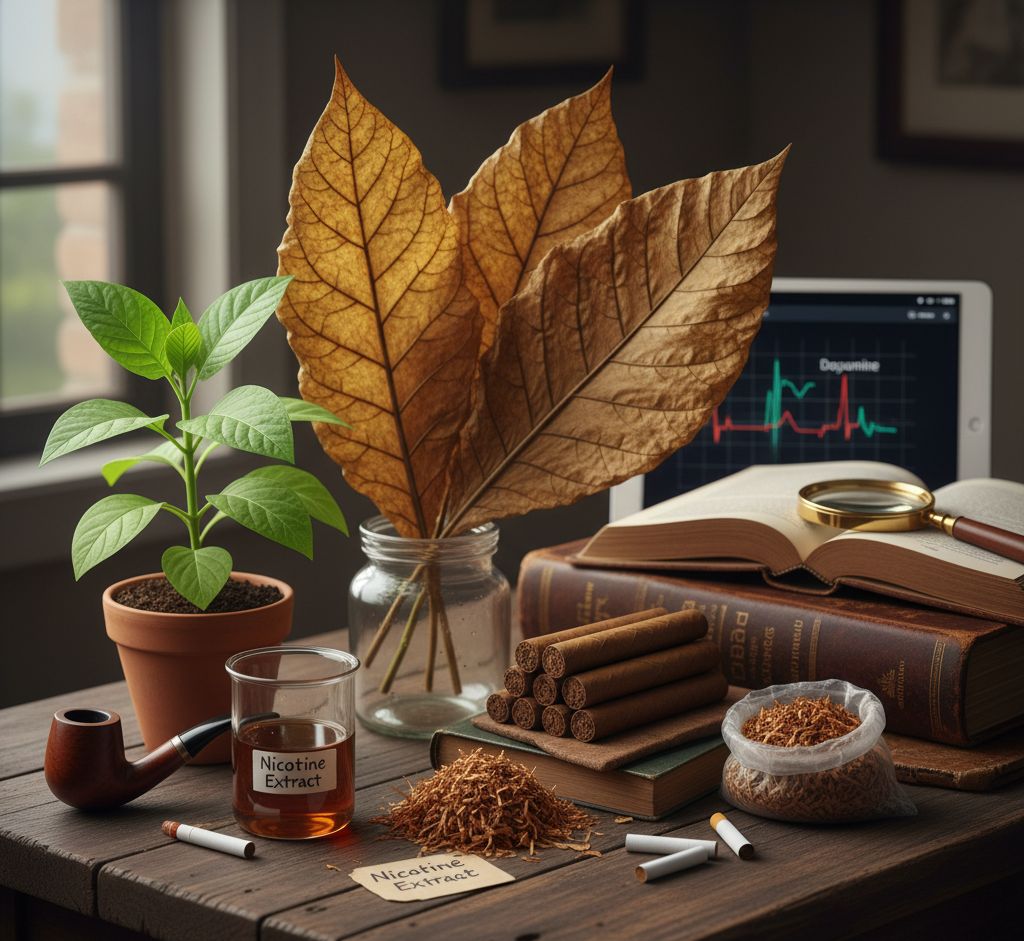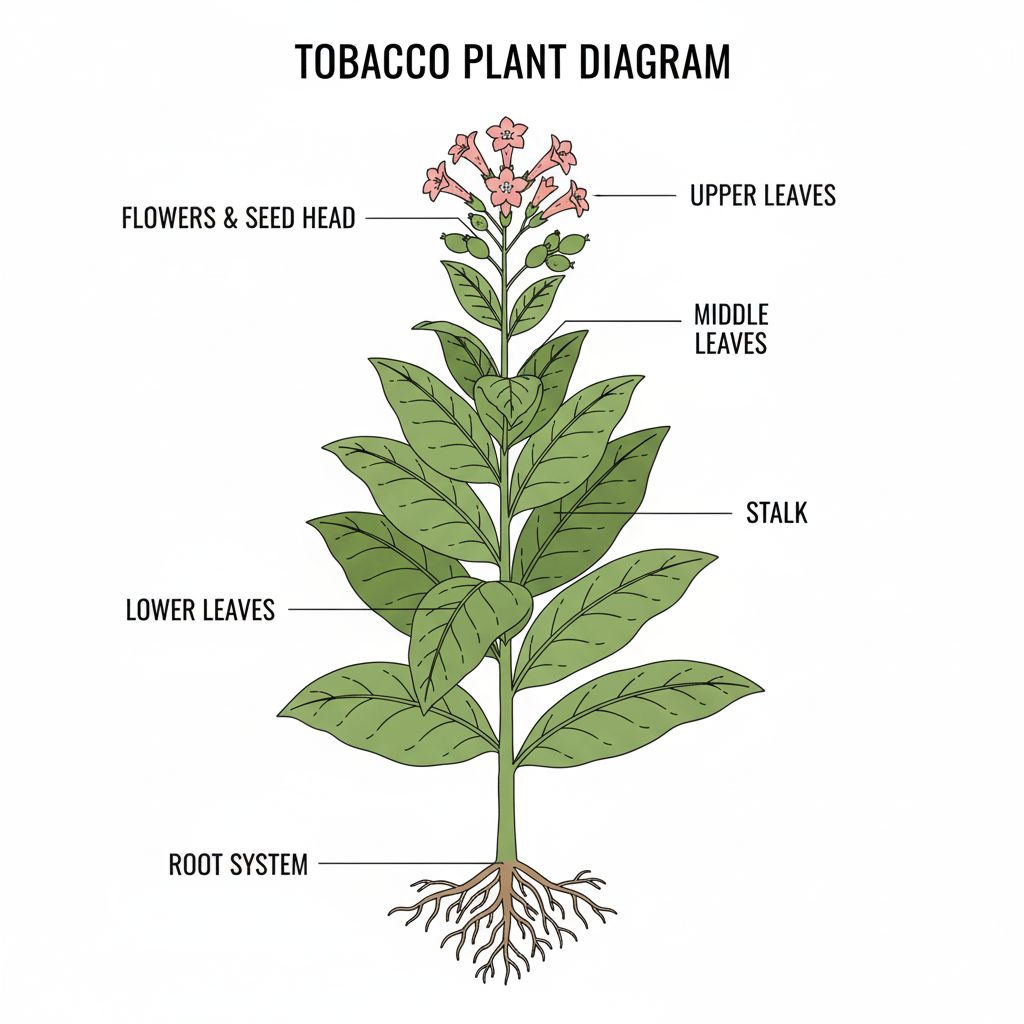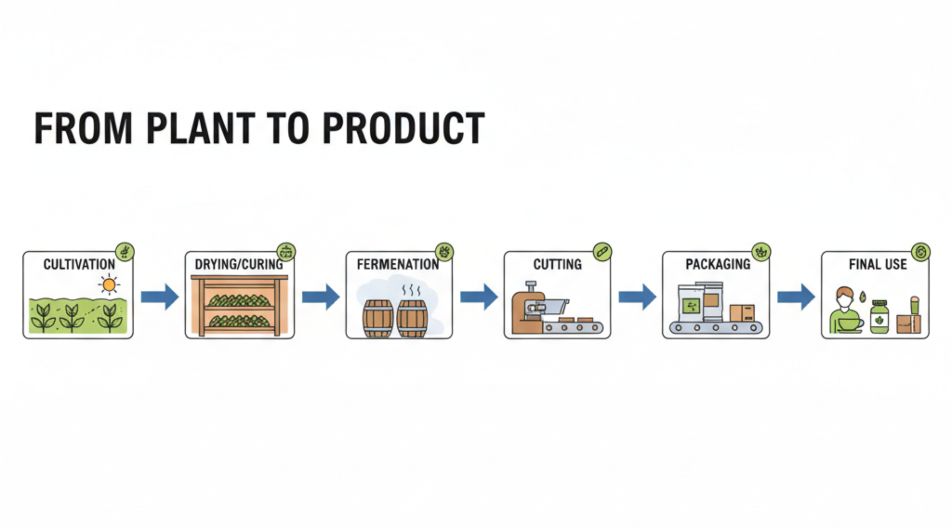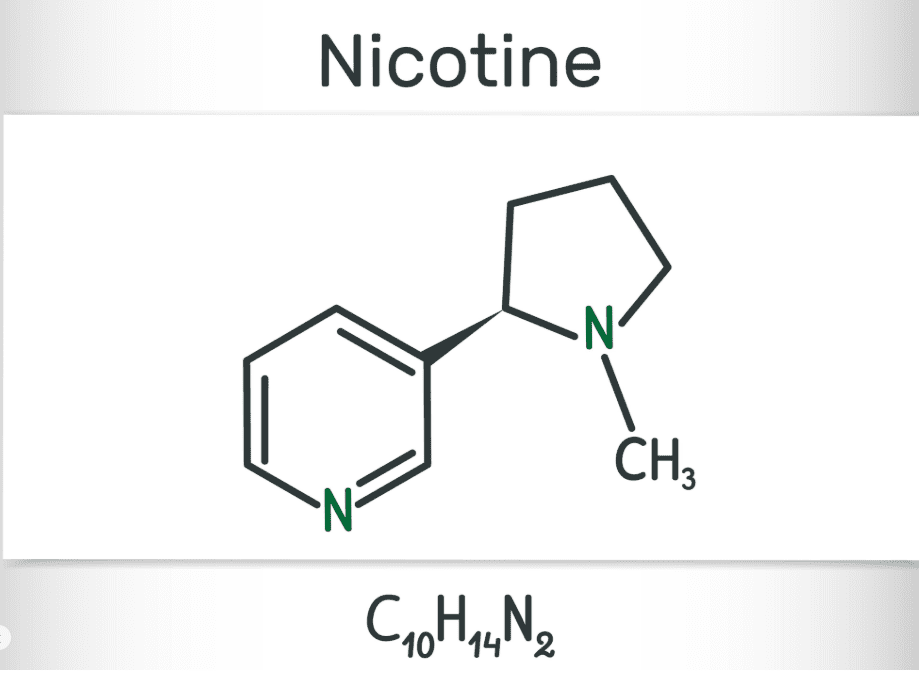
Tobacco is a natural plant product derived primarily from the species Nicotiana tabacum, belonging to the nightshade family (Solanaceae). This broadleaf plant has been cultivated for centuries across the world — mainly in regions like South America, Asia, and Africa — for its distinctive flavor and stimulating properties. The primary active compound in tobacco is nicotine, a naturally occurring psychoactive substance that affects the human brain and body, making tobacco both popular and addictive.
In its raw form, tobacco leaves are harvested, dried, and processed for use in various products such as cigarettes, cigars, pipe tobacco, and chewing tobacco. Because of its high nicotine content, tobacco plays a central role in the global smoking industry, which has shaped cultures, economies, and lifestyles for generations.
While tobacco is a plant-based agricultural product, its defining feature — nicotine — classifies it as a drug due to its stimulant and addictive effects. When consumed, nicotine triggers the release of dopamine, a neurotransmitter associated with pleasure and alertness. This reaction provides temporary relaxation or focus but also leads to dependency over time.
In short:
Tobacco remains one of the world’s most widely cultivated and traded agricultural commodities. It supports millions of farmers globally and serves as the raw material for cigarette manufacturing, snuff, hookah, and tobacco chewing products. Despite health concerns, tobacco continues to play a key role in agriculture, commerce, and industry.
In summary, tobacco is both a plant and a drug — a natural agricultural product whose nicotine content gives it powerful physiological effects. It stands at the crossroads of botany, chemistry, and human culture, influencing societies for centuries.
Tobacco is a leafy plant scientifically known as Nicotiana tabacum, cultivated mainly for its tobacco leaves, which are dried and processed for smoking and other uses. The tobacco plant belongs to the nightshade family (Solanaceae) and is valued for its naturally occurring tobacco alkaloids, primarily nicotine — the compound responsible for its stimulating and addictive effects.
The most important part of the plant is its broad green leaves, which contain a complex mix of organic compounds, including sugars, proteins, alkaloids, and aromatic resins. These elements contribute to tobacco’s distinctive flavor, aroma, and chemical behavior during combustion or processing.
| Component | Description |
| Nicotine | The primary alkaloid; a stimulant affecting the central nervous system. |
| Tobacco Alkaloids | Includes nornicotine, anabasine, and anatabine, contributing to flavor and physiological effects. |
| Carbohydrates & Sugars | Provide mild sweetness and influence burn characteristics. |
| Proteins & Amino Acids | Affect taste and chemical reactions during curing. |
| Resins & Oils | Contribute to aroma and smoke texture. |
In essence, tobacco leaves are the heart of the plant — rich in nicotine and other alkaloids that define the unique properties of tobacco used in cigarettes and other smoking products.
Tobacco has deep historical roots that trace back thousands of years. Tobacco originates from the Americas, specifically Central and South America, where it was first cultivated and used by indigenous peoples long before European contact. Native tribes in these regions grew the tobacco plant (Nicotiana tabacum) for spiritual, medicinal, and ceremonial purposes, often burning or chewing the tobacco leaves to connect with nature and the divine.
When European explorers arrived in the late 15th century, they encountered this remarkable plant and carried it back to Europe, where it quickly gained popularity. Through colonization and global trade, tobacco spread across continents, becoming a valuable cash crop in regions like North America, Africa, and Asia. Its cultivation soon became central to agricultural economies, especially in the Caribbean, Southern United States, India, and China.
Today, tobacco is grown in over 120 countries, with major producers including China, Brazil, India, the United States, and Indonesia.
In summary:
Thus, when we ask “where does tobacco come from?” — the answer lies in the rich cultural and agricultural heritage of the American continents, from where it began its global journey.

The journey of tobacco from a green plant in the field to a finished product like a cigarette or cigar involves several carefully controlled stages. The tobacco production chain ensures that the leaves develop the right flavor, aroma, and texture before being used in various tobacco products.
Tobacco begins with the cultivation of the tobacco plant, which thrives in warm, well-drained soils. Farmers nurture the crop for 2–3 months until the leaves mature and reach the right size and nicotine level.
Once harvested, tobacco leaves are dried and cured using methods such as air curing, flue curing, sun curing, or fire curing. This process develops the leaf’s color, reduces moisture, and enhances flavor compounds.
After curing, the leaves undergo fermentation to balance their chemical composition and remove harshness. They are then sorted, blended, and cut into fine strips according to the intended use.
Processed tobacco is used in various forms, including:
Each product type relies on specific processing techniques to meet desired taste, texture, and nicotine strength.

Yes — tobacco does have nicotine, and it’s the key compound that defines the plant’s stimulating and addictive nature. Nicotine is a stimulant alkaloid naturally found in the tobacco plant (Nicotiana tabacum), concentrated mainly in its leaves. It is one of several tobacco alkaloids, but it stands out for its strong physiological effects on the human brain and body.
When tobacco is smoked, chewed, or inhaled, nicotine quickly enters the bloodstream and travels to the brain within seconds. There, it stimulates the release of dopamine, the “pleasure chemical,” creating a temporary feeling of alertness, relaxation, and satisfaction. However, this effect is short-lived, leading to repeated use and eventual nicotine dependence.
In simple terms, nicotine is the reason tobacco is both stimulating and habit-forming. Although it occurs naturally in the tobacco plant, its powerful interaction with the nervous system makes it a psychoactive drug that influences mood, energy, and behavior.
Many people wonder, “Is tobacco a drug?” — and the answer is yes. Tobacco is classified as a drug because it contains nicotine, a psychoactive and addictive chemical that directly affects the brain and central nervous system. Although tobacco comes from a natural plant, its chemical impact on the body is similar to other commonly used stimulants such as caffeine and alcohol, both of which alter mood, alertness, and behavior.
Nicotine acts as a stimulant alkaloid that interacts with nicotinic acetylcholine receptors in the brain. Within seconds of inhalation or absorption, nicotine causes a surge of dopamine, producing a short-lived sense of pleasure, focus, and calmness. Over time, the brain adapts to this stimulation, requiring more nicotine to achieve the same effect — a hallmark of addiction.
The World Health Organization (WHO) and most medical authorities classify tobacco and nicotine as addictive psychoactive substances, placing them in the same category as other dependence-causing drugs. This classification is based on their effects on mood regulation, reward pathways, and physical dependence.
Long-term use of tobacco can lead to nicotine addiction, making it difficult for users to quit. Beyond addiction, tobacco consumption is linked to serious health issues such as heart disease, lung cancer, respiratory problems, and high blood pressure.
In summary, tobacco is considered a drug not because of its plant origin, but because of nicotine’s psychoactive influence, its ability to create dependence, and its profound effects on human health.

The history of tobacco stretches back thousands of years, beginning with its traditional use among indigenous peoples of the Americas. Long before modern cultivation, Native American tribes in Central and South America used tobacco leaves in spiritual rituals, healing practices, and social ceremonies. It was believed to purify the spirit, aid meditation, and connect individuals with higher powers.
With the arrival of European explorers in the late 15th century, tobacco was introduced to Europe, where it quickly became a luxury commodity. Within a few decades, it spread across Asia, Africa, and the Middle East, carried along trade routes and colonial expansion. Tobacco transformed from a sacred plant to a commercial product, fueling global demand and establishing vast plantation economies.
Over time, the cultural meaning of tobacco shifted — from ritual and spiritual use to a habitual and recreational activity. The rise of cigarettes and mass production in the 19th and 20th centuries further cemented tobacco’s role as both a global industry and an addictive social norm.

Today, tobacco is one of the world’s most significant agricultural commodities, cultivated in over 120 countries and supporting millions of farmers and workers worldwide. Modern tobacco production involves advanced farming, processing, and manufacturing systems that ensure consistent leaf quality and supply for the global market.
The leading tobacco-producing countries include China, India, Brazil, and the United States, which together account for the majority of global production. These nations have developed large-scale cultivation systems and modern processing facilities that transform raw leaves into finished products such as cigarettes, cigars, pipe tobacco, and chewing tobacco.
To meet industrial demands, specialized machinery plays a vital role in every stage of production — from leaf processing to final packaging. Learn more about the latest technologies used in the industry:
Together, these innovations power the global tobacco industry, bridging traditional cultivation with modern manufacturing efficiency.
Tobacco is both a natural plant and a source of a powerful psychoactive substance — nicotine. While it originates from the Nicotiana tabacum plant, cultivated for centuries across the world, its defining chemical composition makes it far more than just an agricultural product. The tobacco leaves that once held spiritual and cultural significance in ancient American traditions have evolved into the foundation of a global industry — one that impacts health, economies, and societies.
Understanding tobacco means recognizing this dual identity: it is a plant gifted by nature, yet one whose nicotine content has made it one of the most addictive substances known to humans. Modern awareness emphasizes the importance of education, regulation, and responsible use, ensuring that consumers understand both the cultural history and health risks associated with tobacco.
Ultimately, tobacco should be viewed beyond the label of a drug — as a complex product that links botany, chemistry, history, and human behavior, reminding us of the need for balanced knowledge and responsible decision-making in its use and production.
Tobacco is composed of naturally occurring compounds found in the Nicotiana tabacum plant. Its main components include:
Tobacco is considered a drug because of its psychoactive and addictive compound — nicotine. According to the World Health Organization (WHO) and the U.S. Centers for Disease Control and Prevention (CDC), nicotine directly affects the central nervous system, altering mood, concentration, and behavior. Its ability to trigger dopamine release leads to dependence, similar to other drugs such as caffeine or alcohol.
Tobacco originated in the Americas, specifically Central and South America, where it was cultivated by indigenous peoples for spiritual and medicinal purposes. European explorers brought it to Europe in the 15th century, from where it spread globally through colonization and trade, eventually becoming one of the world’s most valuable agricultural commodities.
Nicotine is naturally present in the tobacco plant. It is produced in the roots and accumulates in the leaves as part of the plant’s defense mechanism against insects. Tobacco manufacturers do not add nicotine artificially to leaves — though nicotine levels may be adjusted during processing through blending or curing techniques.
Yes. Even natural or organic tobacco contains nicotine and other toxic compounds that can harm the body. When burned or inhaled, tobacco smoke produces tar, carbon monoxide, and carcinogens — substances that are damaging regardless of the tobacco’s source. Organic varieties may reduce chemical fertilizers or pesticides, but they do not eliminate health risks.
When inhaled or absorbed, nicotine travels to the brain within seconds, binding to nicotinic receptors that release dopamine — the neurotransmitter responsible for feelings of pleasure and reward. This creates a short-term boost in alertness and relaxation, followed by cravings as dopamine levels drop. Over time, this cycle causes nicotine dependency, making it difficult for users to quit.
Tobacco is primarily used in the production of cigarettes, cigars, and chewing tobacco, but it also has applications beyond traditional smoking. Modern industries utilize tobacco extracts for pharmaceutical nicotine products such as nicotine patches, gums, and lozenges used in smoking cessation programs. Additionally, tobacco by-products are used in research, pest control, and biotechnology, showcasing its continued industrial relevance.
We specialize in the provision of Tobacco Machinery. Our expertise encompasses not only the trading of machinery but also extends to being a dedicated supplier. This specialization is enriched by our comprehensive solutions tailored for emerging Cigarette Companies. What sets us apart is our ability to offer firsthand insights through our active Cigarette Manufacturing operation in the UAE.